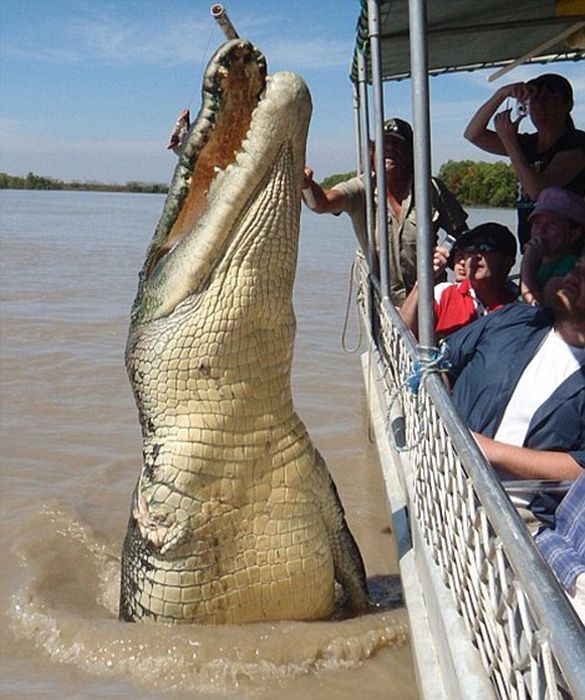|
|
Brutus, The Giant Crocodile
|
Crocodiles are among the more biologically complex reptiles despite their prehistoric look. Unlike other reptiles, they have a cerebral cortex; a four-chambered heart; and the functional equivalent of a diaphragm, by incorporating muscles used for aquatic locomotion into respiration (e.g. M. diaphragmaticus); Their external morphology on the other hand is a sign of their aquatic and predatory lifestyle. A crocodile’s physical traits allow it to be a successful predator. They have a streamlined body that enables them to swim swiftly. Crocodiles also tuck their feet to their sides while swimming, which makes them faster by decreasing water resistance. They have webbed feet which, although not used to propel the animal through the water, allow it to make fast turns and sudden moves in the water or initiate swimming. Webbed feet are an advantage in shallower water where the animals sometimes move around by walking.
Crocodiles have a palatal flap, a rigid tissue at the back of the mouth that blocks the entry of water. The palate has a special path from the nostril to the glottis that bypasses the mouth. The nostrils are closed during submergence. Like other archosaurs, crocodilians are diapsid, although their post-temporal fenestrae are reduced. The walls of the braincase are bony but they lack supratemporal and postfrontal bones. Their tongues are not free but held in place by a membrane which limits movement; as a result, crocodiles are unable to stick out their tongues.
Crocodilian scales have pores that are believed to be sensory, analogous to the lateral line in fishes. They are particularly seen on their upper and lower jaws. Another possibility is that they are secretory, as they produce an oily substance that appears to flush mud off.
Crocodiles are very fast over short distances, even out of water. Since crocodiles feed by grabbing and holding onto their prey, they have evolved sharp teeth for tearing and holding onto flesh, and powerful muscles that close the jaws and hold them shut. These jaws can bite down with immense force, by far the strongest bite of any animal. The pressure of the crocodile's bite is more than 5,000 pounds per square inch (30,000 kPa), compared to just 335 pounds per square inch (2,300 kPa) for a rottweiler, 400 pounds per square inch (2,800 kPa) for a large great white shark, 800 pounds per square inch (6,000 kPa) to 1,000 pounds per square inch (7,000 kPa) for a hyena, or 2,000 pounds per square inch (10,000 kPa) for a large alligator. The jaws are opened, however, by a very weak set of muscles. Crocodiles can thus be subdued for study or transport by taping their jaws or holding their jaws shut with large rubber bands cut from automobile inner tubes. They have limited lateral (side-to-side) movement in their neck.
|
|









